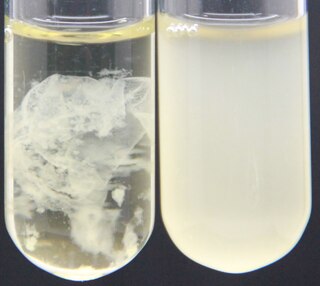Related Research Articles

The Burkholderiales are an order of Pseudomonadota. Like all Pseudomonadota, they are Gram-negative. They include several pathogenic bacteria, including species of Burkholderia, Bordetella, and Ralstonia. They also include Oxalobacter and related genera, which are unusual in using oxalic acid as their source of carbon. Other well-studied genera include Alcaligenes, Cupriavidus, Achromobacter, Comamonas, Delftia, Massilia, Duganella, Janthinobacterium, Polynucleobacter, non-pathogenic Paraburkholderia, Caballeronia, Polaromonas, Thiomonas, Collimonas, Hydrogenophaga, Sphaerotilus, Variovorax, Acidovorax, Rubrivivax and Rhodoferax, and Herbaspirillum.
The Rhodocyclaceae are a family of gram-negative bacteria. They are given their own order in the beta subgroup of Pseudomonadota, and include many genera previously assigned to the family Pseudomonadaceae.

The Rhodocyclales are an order of the class Betaproteobacteria in the phylum "Pseudomonadota". Following a major reclassification of the class in 2017, the previously monofamilial order was split into three families:

The Alteromonadales are an order of Pseudomonadota. Although they have been treated as a single family, the Alteromonadaceae, they were divided into eight by Ivanova et al. in 2004. The cells are straight or curved rods. They are motile by the use of a single flagellum. Most of the species are marine.

The Desulfurococcales are an order of the Thermoprotei, part of the kingdom Archaea. The order encompasses a number of genera which are all thermophilic, autotrophs which utilise chemical energy, typically by reducing sulfur compounds using hydrogen.
In taxonomy, the Desulfurococcaceae are a family of the disc-shaped anaerobic microorganisms belonging to the order Desulfurococcales, in the domain Archaea. Members of this family are distinguished from the other family (Pyrodictiaceae) in the order Desulfurococcales by having an optimal growth temperature below 100 °C, rather than above 100 °C, and by being more diverse. Several genera of the family have been identified.
The Pyrodictiaceae are a family of disc-shaped anaerobic microorganisms belonging to the order Desulfurococcales, in the domain Archaea. Members of this family are distinguished from the other family (Desulfurococcaceae) in the order Desulfurococcales by having an optimal growth temperature above 100 °C, rather than below 100 °C.
In taxonomy, Rhodothalassium is a genus of the Rhodobacteraceae. Up to now there is only one species of this genus known.
In taxonomy, Ignisphaera is a genus of the Desulfurococcales. Ignisphaera aggregans is a coccoid- shaped, fourth type strain that is strictly anaerobes with anaerobic respiration. This archaea species are hyperthermophiles that were found in New Zealand's hot springs in Kuirau Park, Rotorua.
Dehalococcoidia is a class of Chloroflexota, a phylum of Bacteria. It is also known as the DHC group.
The Selenomonadales are an order of bacteria within the class Negativicutes; unlike most other members of Bacillota, they are Gram-negative. The phylogeny of this order was initially determined by 16S rRNA comparisons. More recently, molecular markers in the form of conserved signature indels (CSIs) have been found specific for all Selenomonadales species. On the basis of these markers, the Selenomonadales are inclusive of two distinct families, and are no longer the sole order within the Negativicutes. Several CSIs have also been found specific for both families, Sporomusaceae and Selenomonadceae. Samples of bacterial strains within this order have been isolated from the root canals of healthy human teeth.
The Coriobacteriia are a class of Gram-positive bacteria within the Actinomycetota phylum. Species within this group are nonsporulating, strict or facultative anaerobes that are capable of thriving in a diverse set of ecological niches. Gordonibacter species are the only members capable of motility by means of flagella within the class. Several species within the Coriobacteriia class have been implicated with human diseases that range in severity. Atopobium, Olsenella, and Cryptobacterium species have responsible for human oral infections including periodontitis, halitosis, and other endodontic infections. Eggerthella species have been associated with severe blood bacteraemia and ulcerative colitis.
Coprothermobacterota is a newly proposed phylum of nonmotile, rod-shaped bacteria.
The Silvanigrellaceae are the only family of the order Silvanigrellales, of the class Oligoflexia, of the phylum Pseudomonadota. This family currently harbors the two genera Silvanigrella and Fluviispira
Silvanigrella aquatica is a bacterial species of the phylum Bdellovibrionota. The type strain was isolated from the small lake Nonnenmattweiher located in the Southern Black Forest in Germany. This species is currently the only species in the genus Silvanigrella, which is the only genus in the family Silvanigrellaceae, which is the only family in the order Silvanigrellales. The order Silvanigrellales is one of only two orders in the class Oligoflexia. The type strain MWH-Nonnen-W8red is remarkable due to its low GC content, its pigmentation and its plastic morphology. Of further interest is the relative close relationship of S. aquatica to "Spirobacillus cienkowskii" known as pathogens of daphnids (Daphnia), which are commonly called water fleas. However, S. aquatica is assumed to be a non-pathogenic free-living species. The genome of the type strain was sequenced,
Silvanigrella is a genus of the phylum Bdellovibrionota. The genus currently contains two described species: Silvanigrella aquatica and Silvanigrella paludirubra.
Coprothermobacteraceae is a new bacterial family of rod-shaped microorganisms, belonging to the order Coprothermobacterales, class Coprothermobacteria of the new phylum Coprothermobacterota.
Coprothermobacter is a genus of rod-shaped microorganisms, belonging to the new bacterial family Coprothermobacteraceae of the new phylum Coprothermobacterota. This taxonomic genus has been reclassified in 2018, after different phylogenetic studies showed that these bacteria represented a deeply branched taxon of the domain Bacteria; consequently, the clade including this genus has been classified in a separate phylum from Firmicutes, the phylum where it was included before reclassification.
Emcibacteraceae is a family of bacteria.
Bacteriovoracales is an order of bacteria.
References
- 1 2 Hahn MW, Schmidt J, Koll U, Rohde M, Verbarg S, Pitt A, Nakai R, Naganuma T, Lang E. (2017). "Silvanigrella aquatica gen. nov., sp. nov., isolated from a freshwater lake, description of Silvanigrellaceae fam. nov. and Silvanigrellales ord. nov., reclassification of the order Bdellovibrionales in the class Oligoflexia, reclassification of the families Bacteriovoracaceae and Halobacteriovoraceae in the new order Bacteriovoracales ord. nov., and reclassification of the family Pseudobacteriovoracaceae in the order Oligoflexales". Int J Syst Evol Microbiol. 67: 2555–2568. doi:10.1099/ijsem.0.001965. PMC 5627705 . PMID 28771119.